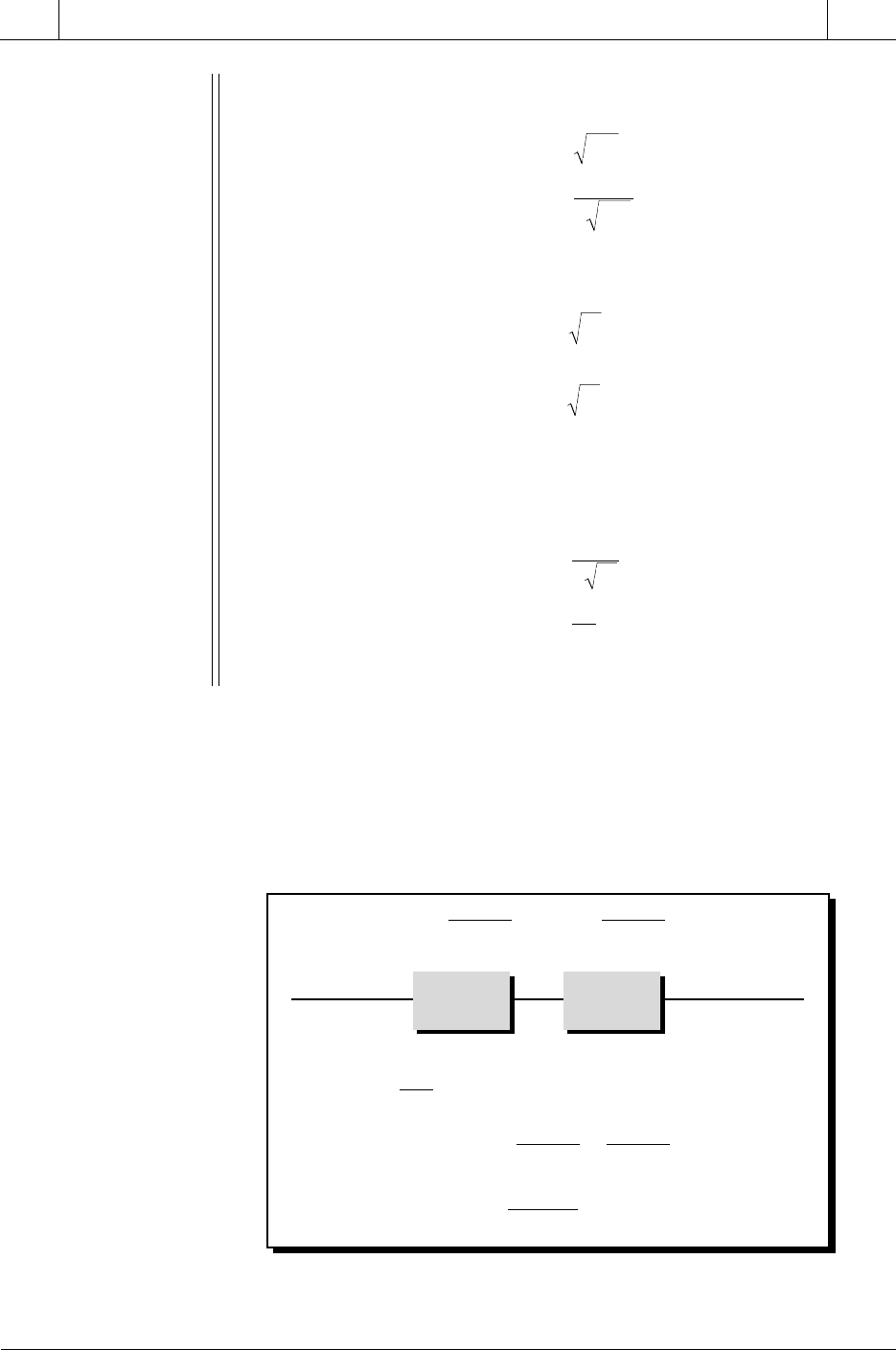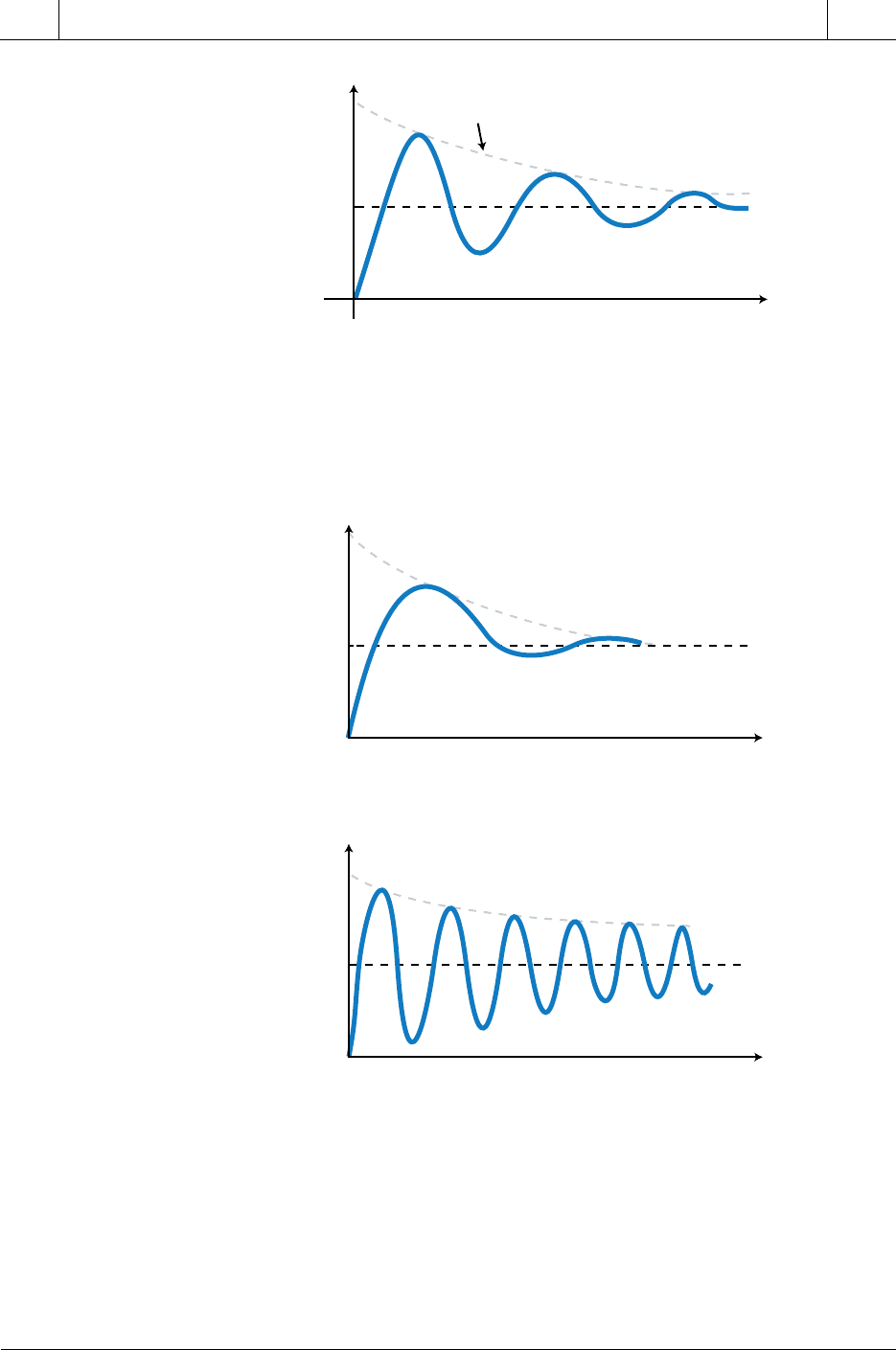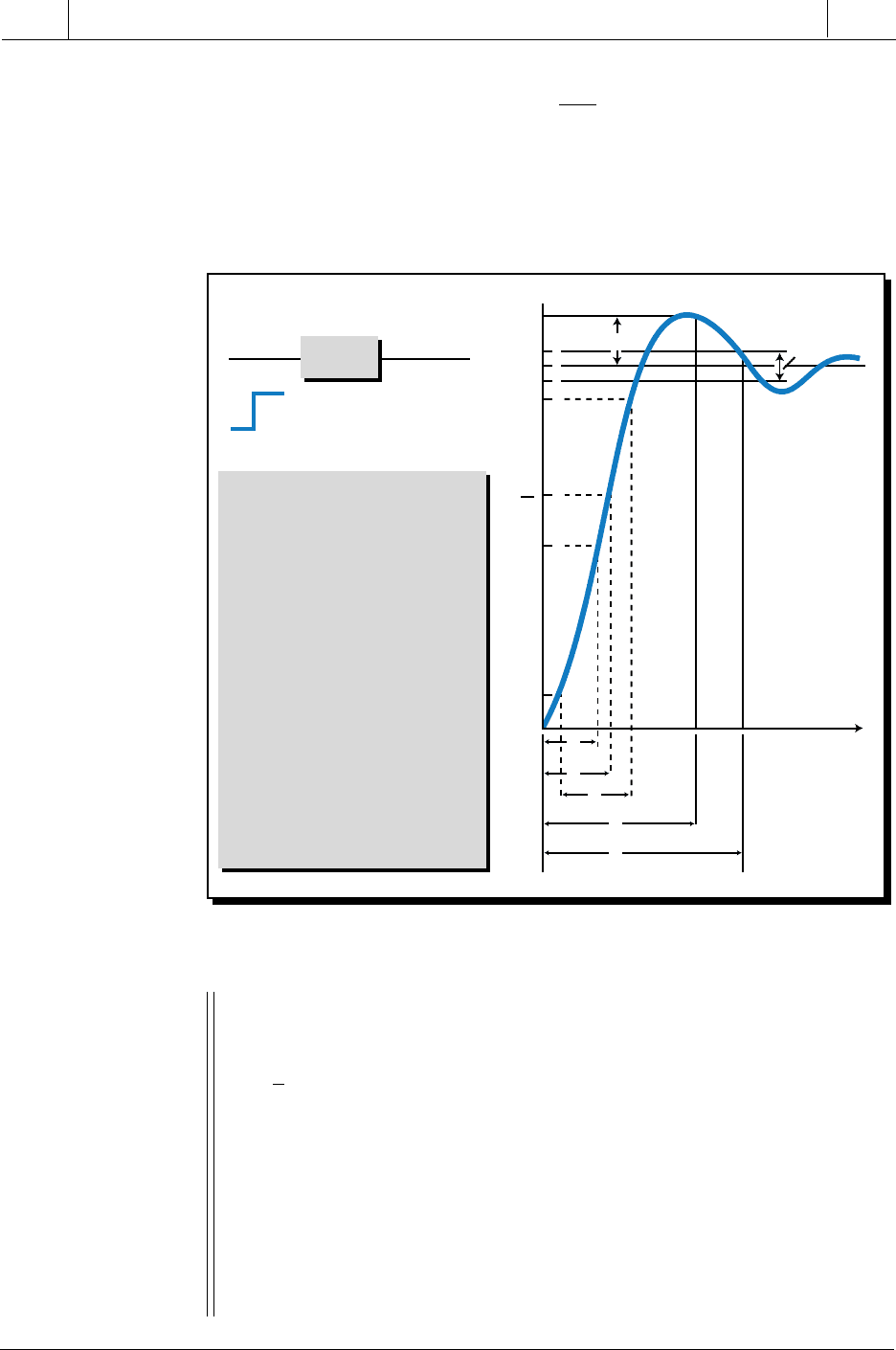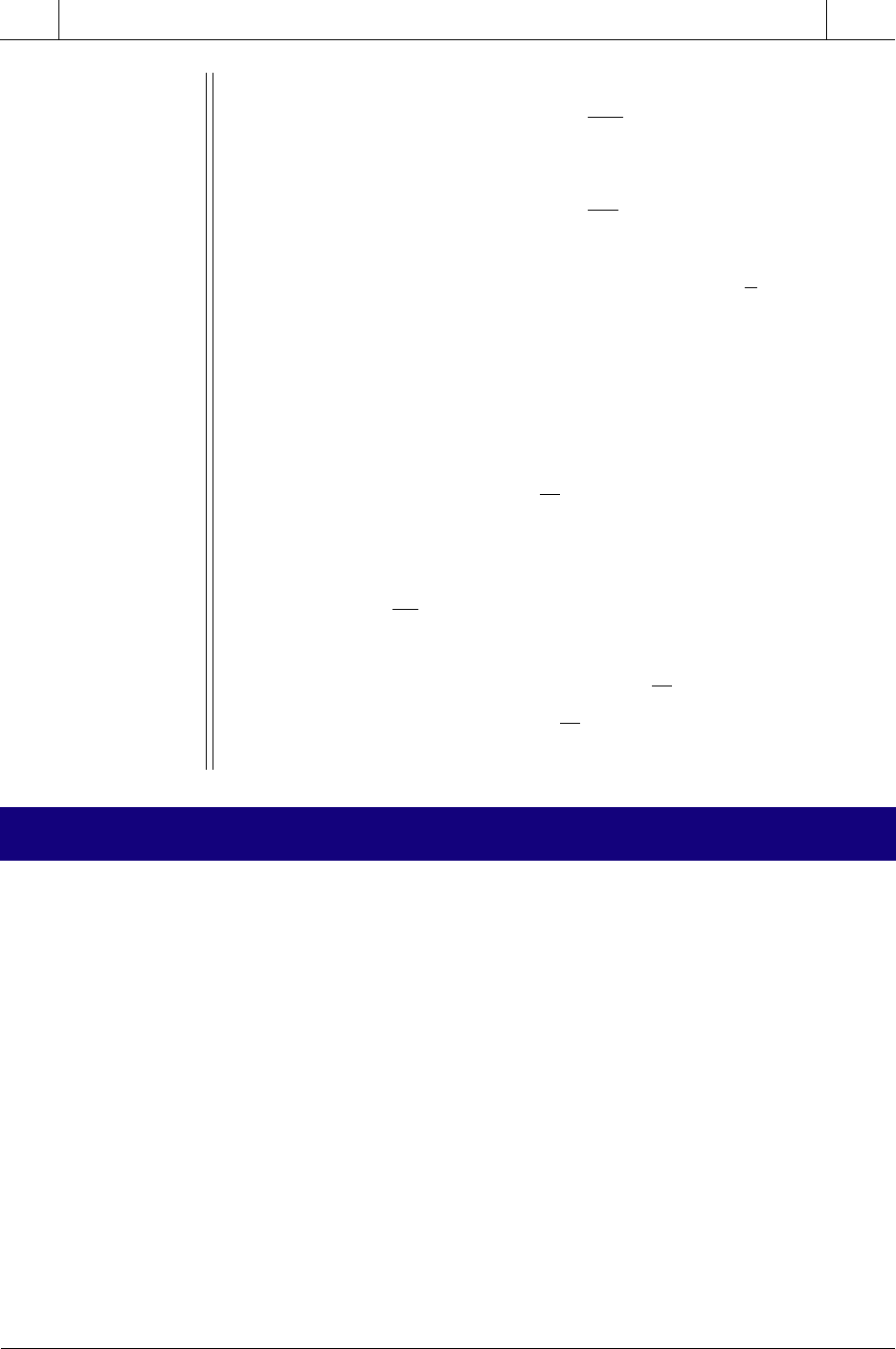Bryan L. Programmable controllers. Theory and implementation
Подождите немного. Документ загружается.


659
CHAPTER
14
Process Responses
and Transfer Functions
Industrial Text & Video Company 1-800-752-8398
www.industrialtext.com
SECTION
4
PLC Process
Applications
Figure 14-53. Two first-order systems with different lag times cascaded to form an
overdamped second-order system.
Out
In
In Out
H
(
s
)1
H
(
s
)2
H
(
s
)
=
H
(
s
)1
H
(
s
)2
H
(
s
)
=
=
A
(τ
1
s
+ 1)
B
(τ
2
s
+ 1)
H
(
s
)1
=
H
(
s
)2
=
A
(τ
1
s
+ 1)
B
(τ
2
s
+ 1)
=
(τ
1
s
+ 1)(τ
2
s
+ 1)
K
sys
()()
H
A
ss
A
s
s()
()()
()
=
++
=
+
ττ
τ
12
2
11
1
This computation comes from substituting ζ = 1 in the second-order lag
transfer function, making the denominator a second-order polynomial of the
form (s
2
+ 2ω
n
s + ω
n
2
):
H
A
ss
A
ss
A
s
s
n
nn
n
nn
n
n
()
=
++
=
++
=
+
()
ω
ζω ω
ω
ωω
ω
ω
2
22
2
22
2
2
2
2
Therefore, substituting K
sys
for the system gain (nominator) and τ
sys
for the
system lag time produces:
H
K
s
s()
=
+
()
sys
sys
τ
1
2

660
SECTION
4
PLC Process
Applications
Industrial Text & Video Company 1-800-752-8398
www.industrialtext.com
CHAPTER
14
Process Responses
and Transfer Functions
EXAMPLE 14-6
Show (a) how to derive the second-order critically damped transfer
function from the second-order lag transfer function and (b) how to
conclude that ζ is equal to 1.
H
A
ss
s
n
nn
()
=
++
(
)
ω
ζω ω
2
22
2
(Second-order transfer function)
H
K
s
s
()
()
=
+
sys
τ 1
2
(Critically damped transfer function)
S
OLUTION
(a) Given that ζ = 1 for a critically damped response, dividing the
numerator and denominator of the second-order function by ω
n
2
yields:
H
A
ss
A
ss
s
n
nn
A
s
s
n
n
n
n
n
n
n
n
n
()
=
++
=
(
)
++
(
)
=
++
(
)
ω
ωω
ω
ω
ω
ω
ω
ω
ω
ω
ω
2
22
2
1
2
2
2
22
2
2
2
2
12
Replacing the term
1
ω
n
with
1
τ
sys
generates the equation:
H
A
ss
A
ss
s
()
=
++
=
++
1
1
2
1
2
1
21
2
τ
τ
ττ
sys
sys
sys sys
Substituting
K
sys
for
A
, this equation forms the critically damped
second-order response:
H
K
ss
K
s
s
()
()
=
++
=
+
sys
sys sys
sys
sys
ττ
τ
2
2
21
1

661
CHAPTER
14
Process Responses
and Transfer Functions
Industrial Text & Video Company 1-800-752-8398
www.industrialtext.com
SECTION
4
PLC Process
Applications
(b) From Example 14-4, we know that:
τττ
ζ
ττ
ττ
sys
2
=
=
+
12
12
1
2
Because τ
1
= τ
2
in a critically damped system, τ
sys
becomes:
τττ
τττ
sys
sys
or
==
==
1
2
1
2
2
2
Since both τ
1
and τ
2
are equal, τ
sys
equals τ. Using the τ
1
and τ
2
equality
in the damping coefficient equation proves that ζ = 1:
ζ
τ
τ
τ
τ
=
=
=
2
2
2
2
1
2
Figure 14-54. Two first-order systems with the same lag time cascaded to form a
critically damped second-order system.
A critically damped system where ζ = 1 indicates that the response of the
system will be rapid as compared to a more sluggish overdamped response
where ζ > 1. Cascading two first-order systems with the same (or nearly the
same) lag time (τ
1
= τ
2
) will produce a critically damped second-order system
response (see Figure 14-54).
Out
In
In Out
H
(
s
)1
H
(
s
)2
H
(
s
)
=
H
(
s
)1
H
(
s
)2
H
(
s
)
=
=
A
(τ
1
s
+ 1)
B
(τ
1
s
+ 1)
H
(
s
)1
=
H
(
s
)2
=
A
(τ
1
s
+ 1)
B
(τ
2
s
+ 1)
=
K
sys
(τ
s
+ 1)
2
(())

662
SECTION
4
PLC Process
Applications
Industrial Text & Video Company 1-800-752-8398
www.industrialtext.com
CHAPTER
14
Process Responses
and Transfer Functions
The inverse Laplace transform of a second-order critically damped system’s
response to a unit step, given that the gain K
sys
equals A
1
A
2
, is (from Table
14-2):
L
−
−
+
=−
−
1
2
1
1
K
ss
K
t
e
t
sys
sys
()
τ
τ
τ
τ
A critically damped system achieves a steady-state value quicker than the
other two types of second-order systems. However, the amplitude of the
overshoot of a critically damped response is larger than that of an
overdamped system.
UNDERDAMPED RESPONSES
Second-order underdamped responses exhibit an over and undershoot
signal (oscillating response) at a natural resonant frequency of ω
n
in radians/
second. This oscillation is the result of a damping factor (ζ) that is less than
1. This means that instead of being able to factor the denominator of the
second-order lag transfer function into a polynomial (i.e., s
2
+ 2ζω
n
s + ω
n
2
),
the denominator becomes a complex-root quadratic equation. The inverse
Laplace transform of this equation produces an exponential, decreasing
sinusoidal response to a unit step input (
1
s
) represented by (from Table 14-2):
L
−
−
++
=+
−
−−
()
1
2
22
2
2
1
2
1
1
1
s
A
ss
A
e
t
n
nn
t
n
n
ω
ζω ω
ζ
ωζψ
ζω
sin
For small values of ζ, this response exhibits a behavior to a unit step
approximate to:
Out
unit step
()
sin( )
t
t
n
Ae t
n
=+
[]
−
1
ζω
ω
This makes the transfer function response approximate to:
He t t
t
t
nn
n
()
sin( ) ( )≈≈
−
=
ζω
ζ
ωωsin
0
which is the form of a sine curve. The response of this equation, shown in
Figure 14-55, illustrates the damping factor ζ of the sinusoidal response. The
closer the damping factor is to 1 (critical damping), the lower the frequency
of oscillation and the sooner it will level off (see Figure 14-56a). Remember
that if ζ = 0, the response will oscillate forever as a sinusoidal response at a

663
CHAPTER
14
Process Responses
and Transfer Functions
Industrial Text & Video Company 1-800-752-8398
www.industrialtext.com
SECTION
4
PLC Process
Applications
Figure 14-55. Underdamped response.
Figure 14-56. Frequency of oscillation is (a) lower when ζ is closer to 1 and (b) higher
when ζ is closer to 0.
frequency ω
n
; therefore, the closer the value of ζ gets to zero (see Figure 14-
56b), the higher the frequency and the longer the oscillations will last (τ
becomes longer).
The exponential sinusoidal response of an underdamped second-order
system will settle to 5% of its steady-state value within 3τ (three time
constants), to 2% within 4τ, and to 0.5% within 5τ. The second-order lag
response (τ
sys
) for an underdamped system is defined as:
t
A
e
(Damping)
–
ζω
n
t
t
A
e
e
t
A
(a)
(b)
(ζ is closer to 1)
(ζ is closer to 0)
–
ζω
n
t
–
ζω
n
t

664
SECTION
4
PLC Process
Applications
Industrial Text & Video Company 1-800-752-8398
www.industrialtext.com
CHAPTER
14
Process Responses
and Transfer Functions
Figure 14-57. Parameters of an underdamped second-order system.
τ
ζω
sys
=
1
n
which indicates that the lag time constant depends on the value of ζ. Figure
14-57 illustrates some typical parameters used to describe underdamped
second-order systems.
EXAMPLE 14-7
Compare the relationship between the first-order time response term
e
t
−
τ
and the second-order, sinusoidal, exponential decay term
e
n
t
−ζω
,
which is used in the underdamped transfer function:
et
n
t
n
−
ζω
ω
sin( )
SOLUTION
The time constant τ
sys
for an underdamped system is equal to:
A
= Amplitude after all gains;
value is at steady state
A
p
= Peak value of the overshoot
t
s
= Time required for the response
to be within tolerance values
(e.g., 5%)
t
p
= Time to peak value
t
r
= Rise time—the time to get
from 10% to 90% of the final
steady-state value
t
= Time constant
t
—the time the
system takes to reach the
value of 1/
e
of
A
(steady-state)
t
d
= Time delay—the time interval
required to reach half of the
steady-state value (0.5
A
) after
an application of input or
disturbance change
In Out
H
(
s
)
Underdamped
Second-Order Process
Step with amplitude
A
A
A
p
1.05
A
A
0.95
A
0.9
A
A
e
0.5
A
0.1
A
Overshoot
Tolerance
Limits
t
t
d
t
p
t
s
t
r
t

665
CHAPTER
14
Process Responses
and Transfer Functions
Industrial Text & Video Company 1-800-752-8398
www.industrialtext.com
SECTION
4
PLC Process
Applications
τ
ζω
ζω
τ
sys
sys
or
=
=
1
1
n
n
The response of a first-order exponential system is
e
t
−
τ
, where τ is the
system’s time constant. Therefore, the decaying term
e
n
t
−ζω
in the
equation:
et
n
t
n
−
ζω
ω
sin( )
is equal to:
et
t
n
−
τ
ω
sys
sin( )
This indicates that, in an underdamped second-order system, the
value of τ
sys
(lag time) becomes larger as the value of ζ becomes
smaller (
τ
ζω
sys
n
=
1
) This is similar to the behavior of a first-order system
with a long lag, because the time to reach the steady-state value will
be long. In a second-order underdamped system, the oscillation
continues for a longer time since the term
e
t
−
τ
sys
provides less damping.
If
ζ = 1, the value of τ
sys
becomes
1
ω
n
, which is the lag time of a critically
damped system.
14-8 SUMMARY
The objective of a process control system is to maintain the process variable
(process output) at a desired target value, referred to as the set point. The
system provides this control by implementing a feedback loop, meaning that
it reads the process variable and compares it to the set point value. The
controller then uses the difference between these values, as computed by E =
SP – PV , to determine how much corrective action it must take. The error,
which the controller calculates as a percentage of the full range of the process
variable, can be caused by changes in the set point or by disturbances to
the process.
Open-loop systems are systems in which the process variable is not fed back
into the control system for reference. Closed-loop systems, on the other hand,
do receive process variable feedback. Most process control systems are
closed-loop systems that receive negative feedback. In a negative feedback
system, the controller determines the error by subtracting the process variable
from the set point.

666
SECTION
4
PLC Process
Applications
Industrial Text & Video Company 1-800-752-8398
www.industrialtext.com
CHAPTER
14
Process Responses
and Transfer Functions
Process dynamics refers to changes in the process that occur due to distur-
bances or changes in the set point. Process gain changes are a result of gains
in the process variable value created by changes in the control variable output.
The dynamics of a process also includes dead time and lag time. Dead time
is the delay that occurs between the moment a change is made in the control
variable and the moment the process variable begins to react to the control
variable change. Lag time is the delay associated with the time required by the
process control loop to bring the process variable to the set point by adjusting
the final control element. The lag time is a finite time required by the control
system to physically adjust the final control element (e.g., a steam valve).
A transient is the process variable response to a change in set point or to the
creation of a disturbance (e.g., a load change). The transient response depends
not only on the dynamics of the process, but also on the characteristics of the
process itself. These characteristics are the result of the transfer functions of
the controller and the process. A transfer function is the mathematical
representation of a system’s response, where the response is computed by
dividing the output by the input. Transfer functions are expressed in the
frequency domain using Laplace transforms, to allow easy algebraic manipu-
lations of the equations. The inverse Laplace transform of a transfer function
converts a frequency-based Laplace response into a time-based response.
Each element in a control system loop has a transfer function associated with
it—the controller has one and the process has one. The combined controller/
process system also has a transfer function. Transfer functions are categorized
as either first-order or second-order responses. First-order systems have one
lag time associated with the process, while second-order systems have two lag
times. Laplace transforms are used to mathematically represent both first-
and second-order process transfer functions, as well as controller transfer
functions and the combination of both process and controller functions in a
closed-loop configuration. Although it is difficult to obtain the actual transfer
function of a process, a knowledge of the type of transfer function expected
from a process response is extremely useful, especially when tuning the
controller.
First-order systems have one lag time, resulting in an exponential, decaying
response. When the system receives a step input change, its open-loop
output will have the following time domain response, which smoothly
follows the input:
VV e
t
out in
=−
()
−
1
τ
The time constant τ specifies the time the output takes to achieve 63.2% of the
final steady-state value. The time constant τ is sometimes referred to as the
63% response time. After 5τ periods have elapsed, the value of the output

667
CHAPTER
14
Process Responses
and Transfer Functions
Industrial Text & Video Company 1-800-752-8398
www.industrialtext.com
SECTION
4
PLC Process
Applications
response will be at 99.33% of its final value. In Laplace form, the transfer
function of a first-order system has the form:
H
A
s
s()
==
+
Out
In
1
1
τ
Second-order systems have two lag times and are described by the transfer
equation:
H
A
ss
s
n
nn
()
==
++
()
Out
In
ω
ζω ω
2
22
2
Second-order systems can have three types of responses, depending on their
damping coefficient: overdamped (ζ > 1), critically damped (ζ = 1), and
underdamped (ζ < 1). Each of these types of responses have different inverse
Laplace transforms, translating into different time domain responses.
Overdamped responses (ζ > 1) have two different time constants (τ
1
and
τ
2
),
and their response over time in reaching the set point is sluggish. Critically
damped systems (ζ = 1) have two lag times, or time constants, that are equal
(τ
1
= τ
2
)
.
These systems reach the set point much faster than overdamped
systems. Underdamped responses (ζ < 1) produce a faster response than either
overdamped or critically damped responses, resulting in an overshoot and
undershoot of the final value that dies off exponentially as the steady-state
value is approached. An underdamped response has two time constants that
are imaginary, or mathematically speaking, that have complex roots pro-
duced by their quadratic equation.
Although some processes have more complicated responses (third- and
fourth-order responses), these processes’ transfer functions can be approxi-
mated by second-order system transfer functions. Most manufacturing pro-
cesses can be classified as either first-order or second-order systems. In the
next chapter, we will discuss how to use PID control to adjust the inputs to
these complex systems to obtain a desired output.
control element
control loop
control variable
critically damped response
dead time
error
error deadband
first-order response
lag time
Laplace transforms
KEY
TERMS

668
SECTION
4
PLC Process
Applications
Industrial Text & Video Company 1-800-752-8398
www.industrialtext.com
CHAPTER
14
Process Responses
and Transfer Functions
overdamped response
process control
process gain
process variable
second-order response
set point
steady state
step response
step test
transfer function
transient response
underdamped response
